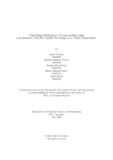| dc.contributor.advisor | Shakil, Arif | |
| dc.contributor.author | Reza, Jamil Ur | |
| dc.contributor.author | Tannee, Khadiza Siddique | |
| dc.contributor.author | Orpa, Sanjana Maruf | |
| dc.contributor.author | Fahim, Hasan Mahmud | |
| dc.contributor.author | Foysal, Riyad | |
| dc.date.accessioned | 2023-05-23T05:18:51Z | |
| dc.date.available | 2023-05-23T05:18:51Z | |
| dc.date.copyright | 2022 | |
| dc.date.issued | 2022-05 | |
| dc.identifier.other | ID 18101693 | |
| dc.identifier.other | ID 18101260 | |
| dc.identifier.other | ID 18101476 | |
| dc.identifier.other | ID 18101318 | |
| dc.identifier.other | ID 18101559 | |
| dc.identifier.uri | http://hdl.handle.net/10361/18308 | |
| dc.description | This thesis is submitted in partial fulfillment of the requirements for the degree of Bachelor of Science in Computer Science, 2022. | en_US |
| dc.description | Cataloged from PDF version of thesis. | |
| dc.description | Includes bibliographical references (pages 30-32). | |
| dc.description.abstract | One of the most devastating cancers in the world is lung cancer. It is estimated
that nearly a third of the world’s cancer fatalities are due to lung cancer. Diagnosis
and treatment of primary and metastatic cancers depend heavily on the ability to
identify and characterize malignant cells. On the other hand, early detection of
lung cancer is crucial for a patient’s survival and significantly increases the survival
rate. Malignant lung nodules may be detected early by oncologists using a variety
of diagnostic methods such as needle prick biopsy and other types of imaging tests
such as CT and PET scanning, as well as clinical examinations and other types of
imaging tests. It’s important to note that these treatments and biopsies are risky. A
higher proportion of people are being infected with the disease, on the other hand.
CT scans are commonly performed in the early stages of cancer detection. Lung
cancer may be detected with a 2.6 to 10-fold higher CT detection rate than analog
radiography, according to Awai [1]. As the slices get thinner, so does their ability to
recognize objects accurately. To evaluate one slice, radiologists need an average of
two to three minutes. The burden of cancer patients is increasing as the number of
those diagnosed grows. CT imaging may be used to detect malignancy and cancerous
nodules in a patient. When cancer nodules (stage I) are discovered, treatment
may begin, and the danger of cancer spreading can be minimized. 70 percent to 92
percent of people diagnosed with stage 1 non-small cell lung cancer (NSCLC) should
expect to live for at least five years following their diagnosis, according to existing
statistics[30] . Considering the fact that a large number of early detection methods
are already available, further research is needed to improve the accuracy of these
methods and, as a consequence, the overall survival rate. Using ConvNeXt, we believe
we can work more efficiently and precisely. Radiologists will also benefit greatly
from this change. The validity of the proposed network was evaluated by comparing
its performance to that of the other pre-trained CNNs, such as GoogleNet, AlexNet,
and ResNet50, using a simulated dataset of pre-processed CT scan images: the Luna
16 dataset. Since our network outperforms the other networks in terms of classification,
accuracy is evident from the results. Aside from pulmonary nodule detection,
this proposal’s approach may be simply adjusted to conduct classification jobs on
any 3D medical diagnostic computed tomography pictures where the classification
is very unpredictable and ambiguous, such as any other 3D medical diagnostic CT
images. | en_US |
| dc.description.statementofresponsibility | Jamil Ur Reza | |
| dc.description.statementofresponsibility | Khadiza Siddique Tannee | |
| dc.description.statementofresponsibility | Sanjana Maruf Orpa | |
| dc.description.statementofresponsibility | Hasan Mahmud Fahim | |
| dc.description.statementofresponsibility | Riyad Foysal | |
| dc.format.extent | 32 pages | |
| dc.language.iso | en | en_US |
| dc.publisher | Brac University | en_US |
| dc.rights | Brac University theses are protected by copyright. They may be viewed from this source for any purpose, but reproduction or distribution in any format is prohibited without written permission. | |
| dc.subject | CNN | en_US |
| dc.subject | ConvNeXt | en_US |
| dc.subject | GoogleNet | en_US |
| dc.subject | AlexNet | en_US |
| dc.subject | ResNet50 | en_US |
| dc.subject.lcsh | Neural networks (Computer science) | |
| dc.subject.lcsh | Image processing | |
| dc.title | Unmasking malignancy of lung nodule using a modernized ConvNet toward the design of a vision transformer | en_US |
| dc.type | Thesis | en_US |
| dc.contributor.department | Department of Computer Science and Engineering, Brac University | |
| dc.description.degree | B. Computer Science | |

